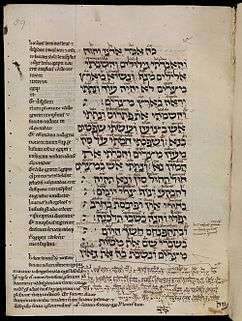Ezekiel 24
| Ezekiel 24 | |
|---|---|
 Book of Ezekiel 30:13–18 in an English manuscript from the early 13th century, MS. Bodl. Or. 62, fol. 59a. A Latin translation appears in the margins with further interlineations above the Hebrew. | |
| Book | Book of Ezekiel |
| Bible part | Old Testament |
| Order in the Bible part | 26 |
| Category | Nevi'im |
Ezekiel 24 is the twenty-fourth chapter of the Book of Ezekiel in the Hebrew Bible or the Old Testament of the Christian Bible. This book contains the prophecies spoken by the prophet Ezekiel, and is one of the Books of the Prophets.[1]
Text
- The original text is written in Hebrew language.
- This chapter is divided into 27 verses.
Textual versions
Some most ancient manuscripts containing this chapter in Hebrew language:
- Masoretic Text
- Codex Cairensis (895 CE)
- Aleppo Codex (10th century)
- Leningrad Codex (1008-1009)
- Dead Sea Scrolls: (2nd century BCE)[2][3]
- 4Q75 (4QEzekc): extant verses 2‑3
Ancient translations in Koine Greek:
- Septuagint
- Theodotion version (~AD 180)
Structure
NKJV groups this chapter into:
- Ezekiel 24:1-14 = Symbol of the Cooking Pots
- Ezekiel 24:15-27 = The Prophet's Wife Dies
Verse 1
- Again, in the ninth year, in the tenth month, on the tenth day of the month,
Cross reference: 2 Kings 25:1-3; Jeremiah 39:1-2; Jeremiah 52:1-6
- "The tenth month" (of the ecclesiastical year on the Hebrew calendar): Tevet. The date corresponds to a day in "January 588 BC".[5]
Verse 2
- "Son of man, write thee the name of the day, even of this same day:
- "Son of man" (Hebrew: בן־אדם ḇen-'ā-ḏām): this phrase is used 93 times to address Ezekiel.[7]
- "Set" (Hebrew: סָמַ֤ךְ sā-maḵ): translated "started his siege" (NKJV); "has laid siege" (NIV); "drew close" (ASV). The Hebrew verb means "lean", "lay", "rest", "support", in the sense of "to place or lay something upon any thing, so that it may rest upon, and be supported by it" or "to lay hand on any thing, so as to lean upon the hand."[8][9]
Verse 24
- "Thus Ezekiel is a sign to you; according to all that he has done you shall do;
- "When this comes": Rashi interprets "this" as "the evil".[11]
See also
- Related Bible parts: 2 Kings 25, Jeremiah 39, Jeremiah 52, Ezekiel 11, 2 Corinthians 1
Notes and references
- ↑ Theodore Hiebert, et al. 1996. The New Interpreter's Bible: Volume VI. Nashville: Abingdon.
- ↑ Timothy A. J. Jull; Douglas J. Donahue; Magen Broshi; Emanuel Tov (1995). "Radiocarbon Dating of Scrolls and Linen Fragments from the Judean Desert". Radiocarbon. 38 (1): 14. Retrieved 26 November 2014.
- ↑ Ulrich 2010, p. 589.
- ↑ Ezekiel 24:1
- ↑ The New Oxford Annotated Bible with the Apocrypha, Augmented Third Edition, New Revised Standard Version, Indexed. Michael D. Coogan, Marc Brettler, Carol A. Newsom, Editors. Publisher: Oxford University Press, USA; 2007. p. 1213-1214 Hebrew Bible. ISBN 978-0195288810
- ↑ Ezekiel 24:2
- ↑ Bromiley 1995, p. 574.
- ↑ Brown, 1994 & "סָמַ֤ךְ".
- ↑ Gesenius, 1979 & "סָמַ֤ךְ".
- ↑ Ezekiel 24:24
- ↑ Rashi's commentary on Ezekiel 24:24.
Bibliography
- Bromiley, Geoffrey W. (1995). International Standard Bible Encyclopedia: vol. iv, Q-Z. Eerdmans. ISBN 9780802837844.
- Brown, Francis; Briggs, Charles A.; Driver, S. R. (1994). The Brown-Driver-Briggs Hebrew and English Lexicon (reprint ed.). Hendrickson Publishers. ISBN 978-1565632066.
- Clements, Ronald E (1996). Ezekiel. Westminster John Knox Press. ISBN 9780664252724.
- Gesenius, H. W. F. (1979). Gesenius' Hebrew and Chaldee Lexicon to the Old Testament Scriptures: Numerically Coded to Strong's Exhaustive Concordance, with an English Index. Translated by Tregelles, Samuel Prideaux (7th ed.). Baker Book House.
- Joyce, Paul M. (2009). Ezekiel: A Commentary. Continuum. ISBN 9780567483614.
- Ulrich, Eugene, ed. (2010). The Biblical Qumran Scrolls: Transcriptions and Textual Variants. Brill.
External links
Jewish
Christian
This article is issued from
Wikipedia.
The text is licensed under Creative Commons - Attribution - Sharealike.
Additional terms may apply for the media files.